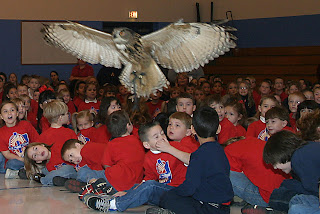Doctor Who, also known as the Whonado and Whobeast, is a female Eurasian Eagle Owl.
She was almost two years old and was definitely one of the bigger training challenges this summer. When we first start training a bird it is best to start at a young age. Since this is when they would be learning life skills from their parents in the wild, it is the easiest time to teach them the behaviors that they will need to know as a show bird. Since we had few education programs at zoos the summer after Who was hatched, this was not the case.
Doctor Who was hatched at the World Bird Sanctuary in our propagation building. Once she reached her full size at three months she was put into free loft, basically given her own room (complete with all the trimmings of a few perches and water bowl). Who lived the bachelorette lifestyle for about a year and a half until we received some happy news. We were going to be doing four zoo shows for the 09 season! Even more exciting was that each show would be flying an eagle owl…except, we only had two flying eagle owls ready for shows. After a lot of patient training the Doctor was ready to head out to Milwaukee as our new show bird. Once there we began working on her show behavior. We started out simply, with short hops from the glove to a stump. It took longer for Dr. Who to grasp "simplicity" than most other eagle owls we've trained. Over time we extended the distance between the glove and stump and later between two different stumps, until Doctor Who could comfortably fly where we directed her.
A Eurasian Eagle Flying just above his head is something a youngster is not likely to forget soon
During the show Doctor Who flew to a perch on the side of the stage and then flew between a series of stumps for a reward, before hopping to a trainer’s glove and being walked offstage. Obviously not rocket science, but it is a tad more complicated for an owl. Despite the fact that many people think owls are highly intelligent, in reality they do not have very large brains. Those beautiful eyes they use to help them hunt actually take up two thirds of the space inside their skull, which does not leave a whole lot of room for a brain. Their eyes are also so large that there is not enough room for the muscles used to turn the eyes, causing owls to always look in one direction. This fixed vision is compensated for by having the ability to turn their heads three quarters of the way around or 270 degrees. They can do this because they have fourteen bones in their neck, whereas all mammals including humans have only seven.
A Eurasion Eagle Owl demonstrate's it's ability to turn it's head 180 degrees--it could go as far as 270 degrees if needed
Like all new stars Doctor Who had some caveats; she was not a morning bird (no flying before noon, period) and she was very picky about her personnel. For the most part the Doctor did her routine well, she loved her tasty rat treats and we had a very long section of script for her. Generally her only issue was pausing for long periods of time in order to stare at the audience, but this allowed us to show off her characteristic orange eyes and her large size. One day she made the discovery that she did not have to remain on her current stump or hop to her trainer, but could in fact fly back to the previous stump…and sit…and stare…and sit a little more. Of course since there was no longer a reward on the stump she eventually learned this was a futile exercise. Because of this training hiccup, many in the audience that day became owl experts.
Now that the show season is over, Doctor Who is back in free loft. She spends most of her time doing what she does best; sitting on her perch, occasionally playing with her chew toy, and eating her dinner…which, like all stars, must be hand delivered to her room.
Submitted by Leah Tyndall, World Bird Sanctuary Naturalist







2 comments:
The bird in the picture is smaller than I expected. I thought females were large.
Females are somewhat larger than the males--although that difference would be difficult to tell from a photo. Also, as in humans, there are size differences in individuals of the species--but as a member of the world's largest owl species, Dr. Who is quite impressive up close--especially from a mouse's eye view!
Post a Comment